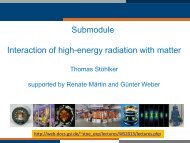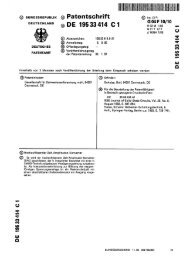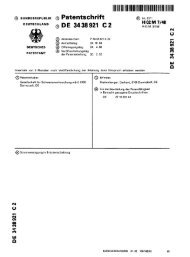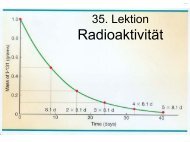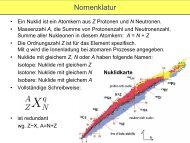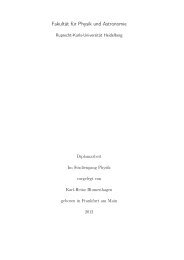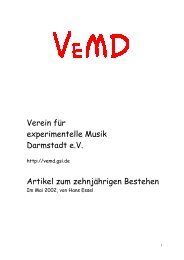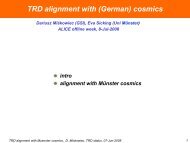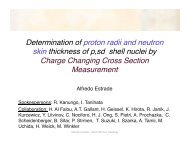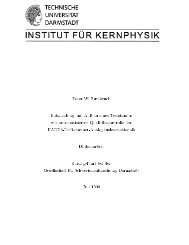PRESPEC Umbrella proposal - GSI
PRESPEC Umbrella proposal - GSI
PRESPEC Umbrella proposal - GSI
You also want an ePaper? Increase the reach of your titles
YUMPU automatically turns print PDFs into web optimized ePapers that Google loves.
S419: <strong>Umbrella</strong> <strong>proposal</strong> for commissioning<br />
of HISPEC/DESPEC detectors<br />
Alejandro Algora / Alison Bruce<br />
(for the <strong>PRESPEC</strong> collabora
What is <strong>PRESPEC</strong>?<br />
Open collabora
High-resolution In-flight SPECtroscopy (HISPEC)<br />
Particle tracking<br />
(Z,pos.,E)<br />
In-beam spectroscopy<br />
using radioactive<br />
beams<br />
γ-ray det.<br />
STFC_Oversight_CommiVee_28 October<br />
FRS Users Mee
Overview of request:<br />
Purpose of test Beam species Number of shiJs<br />
of parasiHc beam<br />
Large-‐area tracking detectors<br />
and use of slowed-‐down<br />
beams<br />
Characterisa
Slowed-‐down-‐beam setup:<br />
Aim: Obtain 5 MeV/u to 10 MeV/u RIB to be used for<br />
secondary reac
Results from the test performed in 2008:<br />
64 Ni beam<br />
simulated background<br />
! 80 % of the beam particles survived slowing down.<br />
! Energy spread after slowing down to<br />
10 MeV/u is 8 MeV/u.<br />
The predicted energy spread is 9 MeV/u.<br />
! Contaminants due to the reactions in the degrader<br />
are of the order of 2%<br />
The quality of the SDB is as<br />
expected!<br />
Plamen Botachkov
Coulomb excitaHon of 64 Ni and 63 Co<br />
and test of large tracking detectors<br />
Counts in 10 days of parasitic beam<br />
time from the 2 + → 0 + transition in 64 Ni<br />
Beam request: 17 days of parasitic beam time<br />
to observe >100 counts in the Coulex peak<br />
of 64Ni and 63Co ! Demonstrate that Coulomb excitation<br />
experiments can be performed with<br />
SDB at FRS<br />
! Test new large area tracking detectors<br />
FRS Users Mee
AGATA detectors:<br />
• characterize the response and performance of AGATA in terms of gamma-‐ and parHcle-‐<br />
background at the FRS. These are features which are difficult to es
AGATA detectors:<br />
• Evaluate the gamma-‐ray hit mulHplicity at a range of target-‐detector distances as it is<br />
foreseen to use the AGATA detectors (for some experiments) at a very short distance from<br />
the target (10 cm). Maximum rate accepted by the detectors (10 kHz).<br />
• Recently, a factor of 3 increase of the high-‐energy background component, commonly<br />
ascribed to light charged par
MONSTER neutron detector:<br />
Measure the beta decay proper
• To determine the performance of the detector<br />
in real condiHons: degrada
BEta deLayEd Neutron detector Features Prototype<br />
• BELEN detector consists of 44 3 He counters<br />
arranged in 3 crowns around the beam hole.<br />
The detector has very high and flat efficiency<br />
(~60%) to minimise energy dependence<br />
FRS Users Mee
BELEN:<br />
Test time requested for:<br />
• Background test of the whole BELEN setup at <strong>GSI</strong><br />
Background has to be reduced as much as possible to allow<br />
measurements of very low yield nuclei. Test time under <strong>GSI</strong> realistic<br />
conditions is required to study shielding needs.<br />
2 days requested<br />
• Integration and callibration:<br />
BELEN detector + Implantation detector (AIDA) + DACQ at <strong>GSI</strong>.<br />
5 days requested with a well known neutron emitter (e.g. 95 Rb).<br />
Two <strong>proposal</strong>s approved at FRS-<strong>GSI</strong> will use the BELEN detector<br />
S323 “Beta-decay of very neutron-rich Rh, Pd, Ag nuclei including the rprocess<br />
waiting point 128Pd”. F. Montes et al.<br />
S410 “Beta-decay measurements of new isotopes near the third r-process<br />
peak”. C. Domingo et al.<br />
FRS Users Mee
Total Absorption Spectrometer<br />
TAS measurements have never been performed at an in-flight<br />
fragmentation facility<br />
Therefore we propose to study:<br />
1. The response of the detectors to the particular background conditions<br />
associated with the implantation of high energy beams<br />
Test of NaI(Tl) and LaBr 3 :Ce prototype modules response (recovery<br />
from saturation) close to a passive implanter at FRS S4 focal plane<br />
LaBr 3:Ce<br />
NaI(Tl)<br />
FRS Users Mee
Total Absorption Spectrometer<br />
2. Perform a measurement with a functional prototype (at least 8 NaI<br />
modules) and an active stopper (AIDA)<br />
Test the event reconstruction performance and its ability to reject<br />
backgrounds<br />
AIDA<br />
• use beams already measured with TAS<br />
at ISOL facilities<br />
• use short/long half-lives to investigate<br />
on-spill/off-spill differences<br />
FRS Users Mee
Physics goals at DESPEC<br />
• In order to fully exploit possibilities at DESPEC the measurement of<br />
absolute transition probabilities is of paramount importance<br />
• Absolute reference is required by other measurement for<br />
normalization<br />
• The fast timing technique can measure level lifetimes:<br />
⸪ Beta decay: βγγ, 5 ps precision with beams down to 20 counts/s.<br />
⸪ Isomeric decay: γγ, 5-10 ps precision with 10 isomers/min.<br />
⸪ In beam: γγγ and γγγγ, to be further explored.<br />
Commissioning within <strong>PRESPEC</strong><br />
• Demonstrate that fast timing experiments can be performed.<br />
• Address the challenges derived from the integration in a slowed down<br />
beam setup<br />
• This can be partially achieved with existing equipment<br />
FRS Users Mee
140 Ba decay<br />
Luis Mario Fraile<br />
• Beams of standard fast-timing<br />
sources, used in other facilities allow<br />
direct comparison to other experiment<br />
conditions: 24 Na, 88 Rb, 140 Ba<br />
• Time resolution can be measured<br />
and time calibration procedures can be<br />
applied for an array of detectors
We would like to explore under realistic experimental conditions:<br />
• Effect on energy and time resolution.<br />
• Time response of the active stopper for timing studies.<br />
• Impact of extended source and position resolution.<br />
• Effect of shielding and scattering processes in a realistic<br />
arrangement at FRS: optimization of the setup.<br />
• Impact of the FRS background conditions on the time<br />
calibrations.<br />
• Possibilities of alternative photosensors in realistic conditions.<br />
• Integration of front-end electronics and data acquisition.<br />
38.1/25.4 x 38.1 mm 5% Ce doping<br />
(2009)<br />
Time resolution 140-145 ps FWHM<br />
at 1.3 MeV - Tested ISOLDE<br />
Luis Mario Fraile
Overview of request:<br />
Purpose of test Beam species Number<br />
of shiJs of<br />
parasiHc<br />
beam<br />
Large-‐area tracking<br />
detectors and use of<br />
slowed-‐down beams<br />
Characterisa



